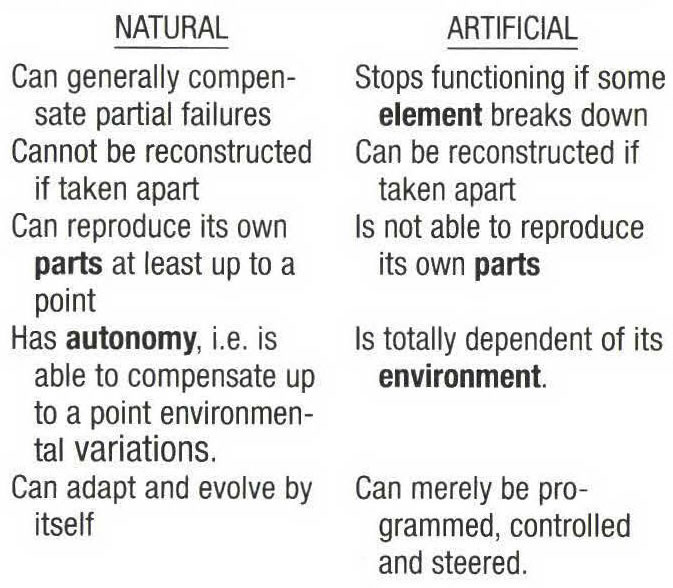MACHINE 1)2)
← Back
1. Anything "which behaves in a machine-like way, namely, that its internal states, and the state of its surroundings, defines uniquely the next state it will go to" (W.R. ASHBY, 1981, p.53).
2."A set of material elements disposed in such a way to permit the execution of some definite operation" (L. COUFFIGNAL, 1951, p.17).
COUFFIGNAL distinguished:
"Natural machines: Machines composed of organs of living beings" (Ibid).
To talk about "Natural machines" seems inconvenient, since it tends to perpetuate the strong dominance of the mechanistic model of nature.
Even so, the metaphor is still very strongly sustained, as shown by the following (1984) text by J.L. DENEUBOURG et al: "The ants' nest seems to be like a machine which has no breakdowns and which is remarkably adaptable thanks to its design. A machine like this only needs to be partially programmed, since its programme organises itself".
Of course, "nobody" designed the ants' nest, nor wrote down a program for it. The authors concedes as much: "… when you observe an ants' nest, you can't help but think that it embodies another solution: that of self-organization".
They moreover observe: "In a world which lays more and more value on machine autonomy, subservient systems designed to process larger amounts of information evermore rapidly provide an initial answer". They conclude that both solutions "will perhaps be complementary in the post-industrial culture" (Ibid).
The still unsolved problem is how to find a way to let the various subsystems interact simultaneously, in real time, allowing for some more or less deterministic chaotic behavior without sinking into total incoherence, i.e. how to organize emergent organization at the global system level.
"Artificial" machines: (according to COUFFIGNAL): "Machines constructed by man, for the purpose of replacing him in some action".
He adds: "We may agree that the lack of any qualificative means "artificial machines", i.e. machines in the older sense" (Ibid).
The artificial machine must be constructed, i.e. structured according to a project or program and its use depends in turn on a functional program. Apart from wear and tear, or being out of order, which are limitative degradations of structure and function, it cannot produce any new and original behavior and has no self-reproduction capacity.
Further on, COUFFIGNAL writes:
"As we have seen, it is from the artificial machines towards the natural ones that, in most cases, a partial similarity will be extended, when found out. Let us remember, to use a precise terminology, that an artificial machine, constructed in view of applying the analogic method, is a mechanical model" (p.19).
As an historical example, COUFFIGNAL explains the artificial nerve, constructed by Ralph LILLIE in 1922, whose behavior led physiologists to admit that the transmission of nervous influx is a physico-chemical phenomenon. This conclusion has been widely confirmed by neurology before and after COUFFIGNAL's paper (1951).
However, as COUFFIGNAL still states: "… analogy must be applied mainly to functional similarities, and in a lesser fashion, to similarities of organs (p.21).
In any case, one wonders if, for many people, the machine analogy is really more than a frequently quite feeble metaphor, imprudently used.
To put some order and avoid dubious isomorphies, it is possible to establish a comparison between specific characteristic of so called "natural" machines and artificial ones.

According to H. ATLAN "… a machine can be formally defined in the most general possible way by a set E of internal states and a set l of inputs. The machine's working is the way by which the inputs and internal states at a given moment determine the internal states at the next moment…
"We speak of self-organization in a strict sense, if the machine is able to change itself its function F, without any environmental interference, in such a way as to become ever better adapted to its own aim.
"Would this be possible, it would mean that F does modify itself" (as an exclusive consequence of the set of its internal states) (1972, p.25).
Such a conclusion could not easily be sustained. Indeed, in this case, the "machine" would be an isolated system, rigidly submitted to the Second Principle of thermodynamics, and the progressive increase of produced entropy, not compensated, would lead it to total disorganization.
Besides, the machine as described by ATLAN, is strictly deterministic. Thus, it cannot be a satisfying model for complex systems and we should remain very careful with the "machine" metaphor, as used at least since the 17th. century.
Categories
- 1) General information
- 2) Methodology or model
- 3) Epistemology, ontology and semantics
- 4) Human sciences
- 5) Discipline oriented
Publisher
Bertalanffy Center for the Study of Systems Science(2020).
To cite this page, please use the following information:
Bertalanffy Center for the Study of Systems Science (2020). Title of the entry. In Charles François (Ed.), International Encyclopedia of Systems and Cybernetics (2). Retrieved from www.systemspedia.org/[full/url]
We thank the following partners for making the open access of this volume possible:

